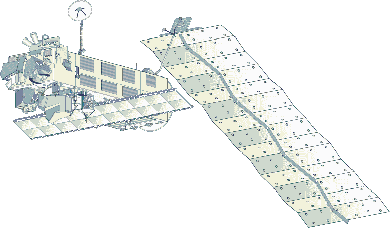 |
 |
 ENVISAT - MERIS - Medium Resolution Imaging Spectrometer (on ENVISAT Satellite, European Space Agancy)
ENVISAT - MERIS - Medium Resolution Imaging Spectrometer (on ENVISAT Satellite, European Space Agancy)

Envisat was successfully launched on 1 March 2002!MERIS is a medium resolution imaging instrument to be carried aboard the ESA's Envisate satellite. The Envisat satellite is scheduled to be launched in November 2001. The primary mission of MERIS is primarily dedicated to ocean and coastal sea water colour observations. Knowledge of the sea colour can be converted into a measurement of chlorophyll pigment concentration, suspended sediment concentration and of aerosol loads over the marine domain. The instrument can also be used for atmospheric and land surface related studies. The global mission of MERIS will have a major contribution to scientific projects which seek to understand the role of the oceans and ocean productivity in the climate system through observations of water colour and will further our ability to forecast change through models. Secondary objectives of the MERIS mission will be directed to the understanding of atmospheric parameters associated with clouds, water vapour and aerosols in addition to land surface parameters, in particular vegetation processes. MERIS will have a high spectral and radiometric resolution and a dual spatial resolution (1200m and 300m), within a global mission covering open ocean and coastal zone waters and a regional mission covering land surfaces. MERIS Spectral Bands
MERIS is designed to acquire 15 spectral bands in the 390 - 1040 nm range. One of the most outstanding features of MERIS is the programmability of its spectral bands in their width and position, in accordance with the priorities of the mission. The above table has been derived for oceanographic and interdisciplinary applications.
The exact position of the MERIS spectral bands will be determined following
a detailed spectral characterization of the instrument. The spectral range is
restricted to the visible near-infrared part of the spectrum between 390 and
1040 nm. The spectral bandwidth is variable between 1.25 and 30 nm depending
on the width of a spectral feature to be observed and the amount of energy needed
in a band to perform an adequate observation. Over open ocean an average bandwidth
of 10 nm is required for the bands located in the visible part of the spectrum.
Driven by the need to resolve spectral features of the Oxygen absorption band
occurring at 760 nm a minimum spectral bandwidth of 2.5 nm is required.
Link to: Envisat Web Page (http://envisat.esa.int/) from the European Space Agency (ESA) MERIS Instrument Web Page (http://envisat.esa.int/instruments/meris/index.html)  Back to Main Index Back to Main Index
|